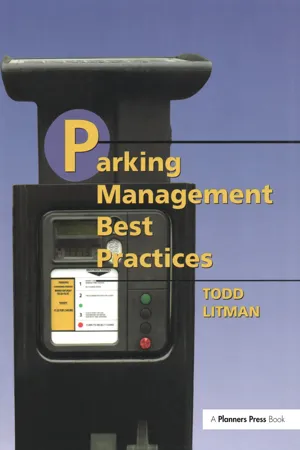
- 312 pages
- English
- ePUB (mobile friendly)
- Available on iOS & Android
Parking Management Best Practices
About This Book
This book is a blueprint for developing an integrated parking plan. It explains how to determine parking supply and affect parking demand, as well as how to calculate parking facility costs. It also offers information about shared parking, parking maximums, financial incentives, tax reform, pricing methods, and other management techniques. What types of locations benefit from parking management? Places with perceived parking problems. Areas with rapidly expanding population, business activity, or traffic. Commercial districts and other places with compact land-use patterns. Urban areas in need of redevelopment and infill. Places with high levels of walking or public transit or places that want to encourage those modes. Districts where parking problems hinder economic development. Areas with high land values Neighborhoods concerned with equity, including fairness to nondrivers. Places with environmental concerns. Unique landscapes or historic districts in need of preservation, "
Frequently asked questions
Information
Chapter
1
Introduction
- Improving user quality of service.
- Creating more accessible land-use patterns.
- Reducing motor vehicle traffic.
- Reducing congestion, accidents, and pollution.
- Creating more attractive communities.
- Improving mobility for nondrivers.
- Strategies That Increase Parking Facility Efficiency
- Share parking.
- Regulate parking.
- Establish more accurate and flexible standards.
- Establish parking maximums.
- Provide remote parking and shuttle services.
- Implement smart growth policies.
- Improve walking and cycling conditions.
- Increase capacity of existing parking facilities.
- Strategies That Reduce Parking Demand
- Implement mobility management.
- Price parking.
- Improve pricing methods.
- Provide financial incentives.
- Unbundle parking.
- Reform parking taxes.
- Provide bicycle facilities.
- Support Strategies
- Improve user information and marketing.
- Improve enforcement and control.
- Establish transportation management associations and parking brokerage.
- Establish overflow parking plans.
- Address spillover problems.
- Improve parking facility design and operation.
- Perception of a parking problem.
- Rapid population, business activity, or traffic growth.
- Compact land-use patterns, such as a commercial district.
- Consumer choice: People should have a variety of parking and travel options from which to choose.
- User information: Motorists should have information on their parking and travel options.
- Sharing: Parking facilities should serve multiple users and destinations.
- Efficient utilization: Parking facilities should be sized and managed so spaces are frequently occupied.
- Flexibility: Parking plans should accommodate uncertainty and change.
- Prioritization: The most desirable spaces should be managed to favor higher-priority uses.
- Pricing: As much as possible, users should pay directly for the parking facilities they use.
- Peak management: Special efforts should be made to deal with peak demand.
- Quality versus quantity: Parking facility quality should be considered as important as quantity, including convenience, comfort, aesthetics, and security.
- Comprehensive analysis: All significant costs and benefits should be considered in parking planning.
- Efforts to redevelop and infill urban areas.
- High levels of walking and public transit use or a desire to encourage these modes.
- Perception that parking problems are a constraint to economic development.
- High land values.
- Concerns about equity, including fairness to nondrivers.
- Environmental concerns.
- A desire to preserve unique landscapes, historic districts, or building design features.
Paradigm Shift
Benefits
- Facility cost savings: These savings reduce costs to governments, businesses, developers, and consumers.
- Improved quality of service: Many strategies improve user quality of service by providing better information, increasing consumer options, and reducing congestion, and by creating more attractive facilities.
- More flexible facility location and design: Parking management gives architects, designers, and planners more ways to address parking requirements.
- Revenue generation: Some management strategies generate revenues that can fund parking facilities, transportation improvements, or other important projects.
- Reduction of land consumption: Parking management can reduce land requirements and help preserve greenspace and other valuable ecological, historic, and cultural resources.
- Mobility management support: Parking management can help encourage more efficient use of the transportation system, which helps reduce traffic congestion, roadway costs, pollution emissions, energy consumption, and traffic accidents.
- Smart growth support: Parking management helps create more accessible and efficient land-use patterns, and supports other strategic land-use planning objectives.
- Improved walkability: By allowing more compact development, and more flexible site design, parking management helps create more walkable communities.
Table of contents
- Cover
- Title
- Copyright
- Contents
- Acknowledgements
- Preface
- List of Figures
- List of Tables
- 1. Introduction
- 2. How Much is Optimal?
- 3. Factors Affecting Parking Demand and Requirements
- 4. Parking Facility Costs
- 5. Parking Management Strategies
- 6. Developing an Integrated Parking Plan
- 7. Evaluating Individual Parking Facilities
- 8. Examples
- 9. Glossary
- 10. References
- Index